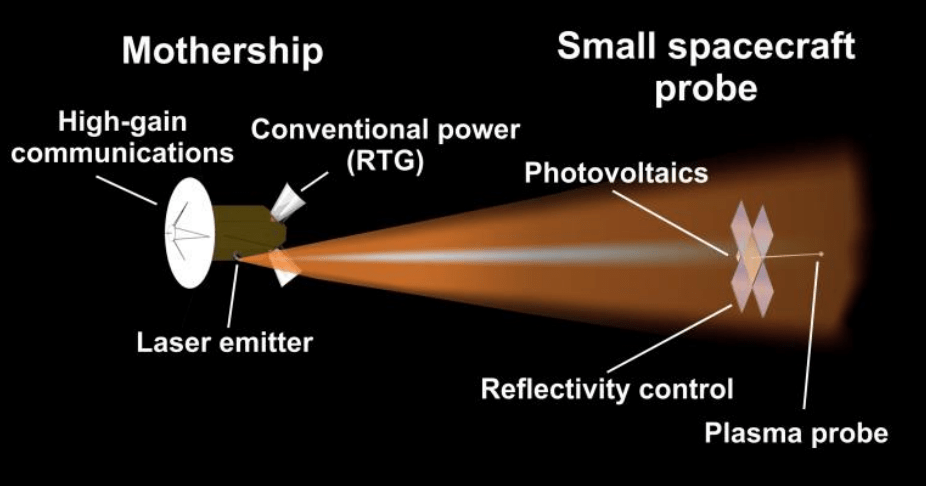We Could SCATTER CubeSats Around Uranus To Track How It Changes
By Andy Tomaswick
Exploration missions to the outer solar system are still sorely lacking, even though they were highly prioritized in the Planetary Science Decadal Survey from 2013-2022. In fact, many planets in the outer solar system have never even been orbited by a probe. For one in particular – Uranus – we must rely on data from Voyager 2, with instruments designed over 50 years ago, or Earth-based observations. Neither solution can genuinely understand the weird physics going on with this planet that is essentially lying on its side. And while there have been plenty of proposed mission architectures to go and look at it, it’s always fun to take a look at a new one when it pops up. A team from Stanford came up with a new concept called the Sustained CubeSat Activity Through Transmitter Electromagnetic Radiation (SCATTER). It was given a NASA Institute for Advanced Concepts grant to develop the idea further. They released a paper a little while ago, and it’s worth digging into here.
One major hurdle to overcome in exploring Uranus is how to power a mission there. It’s too far away for solar panels to effectively be of much use, so the only other viable option is a radio-isotope thermal generator (RTG). These were used on missions such as the Voyager probes and have been incrementally improved since then. However, they are big and bulky, making them impractical for smaller satellites.
Uranus also has a dynamic environment that would be hard to monitor from just one satellite. Its magnetic field, one of the most exciting parts of the Uranian system, changes almost daily. A single orbital probe would be unlike to detect the necessary changes in that system, given it can only gather a single spatial point of data on the magnetic field at any given time.
It would be better to have multiple probes with sensors placed throughout the Uranian system. That way, they could watch the dynamic changing of the magnetic field as it happens from different spatial vantage points. But any such multi-prove system would be prohibitively expensive to send to Uranus with their own RTGS.
So Dr. Sigrid Close and her team at Stanford decided to try another up-and-coming technique to see if they could solve the problem – power beaming. Recently we reported on a successful test of a power satellite beaming power back to Earth as part of a first-of-its-kind experiment. However, nothing in the laws of physics limits that power beaming from a satellite back to a ground station. The same technology can remotely power any device anywhere in the solar system.
The system that Dr. Close and her team developed hinged on the idea of a base station with a powerful RTG that would then release a series of smaller CubeSats with sensors on them throughout their Uranian system. The base station would then serve as a power source and communications hub for the CubeSats throughout the system. It would generate energy using its RTG and transmit it to the CubeSats via power beaming. Those CubeSats, in turn, would monitor the local environment they are situated in and relay data like magnetic fields and other EM radiation back to the base station, which can then transmit it back to Earth using its much more robust communication system.
Moreover, the CubeSats could also potentially use the energy beamed to them from the base station to navigate. By deploying a type of solar sail, the CubeSats could use the radiation pressure provided by the power beam to wind their way through the Uranian system, which, in addition to the massive planet, contains at least 27 different moons.
Understanding the fundamental physics behind the power beaming and the sail propulsion system was the focus of a report from Dr. Close and her colleagues published at the AIAA SCITECH Forum in 2022. Primarily the interest was on what size of CubeSat would be ideal for the mission. They settled on a 0.5U Cubesat measuring about 10cm x 10cm x 5cm and weighing about 500g. This configuration brought the best trade-off between agility and the ability to transfer power.
This is only one of plenty of concepts put forward for our next mission to Uranus, and, despite being completed back in 2021, it’s unclear whether any active research is ongoing with the project. However, there are plenty of steps to go before it can launch. The paper suggests a launch window in the 2043-2045 time frame, with an arrival to the planet in 2054, so there is still plenty of time to flesh out the mission architecture further. But for now, even spreading the novel concept is worthwhile, whether the mission ever sees the light of day.
Learn More:
Lee et al. – EXPLORING URANUS THROUGH SCATTER (SUSTAINED CUBESAT/CHIPSAT ACTIVITY THROUGH TRANSMITTED ELECTROMAGNETIC RADIATION)
Lee et al. – Supporting Uranus Exploration with Deployable ChipSat Probes
UT – Ten Interesting Facts About Uranus
UT – What Mission Could Detect Oceans at Uranus’ Moons?
Lead Image:
Depiction of the SCATTER probe concept.
Credit – Lee et al.
The post We Could SCATTER CubeSats Around Uranus To Track How It Changes appeared first on Universe Today.

August 10, 2023 at 02:51AM
via Universe Today read more...

Post a Comment